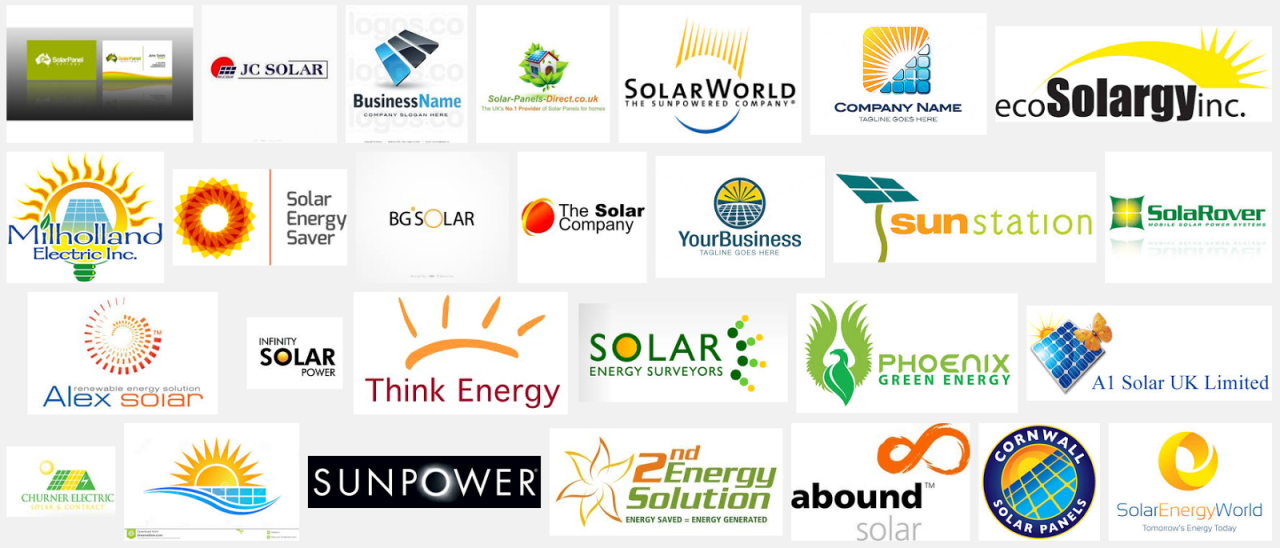
- Solar Electricity Companies
- Types of Solar Electricity Companies
- Solar Electricity Technology
- Solar Electricity Market Trends
- Environmental Impact of Solar Electricity
- Solar Electricity Companies: Case Studies
- The Future of Solar Electricity
- Final Conclusion: Solar Electricity Companies
- FAQ Compilation
Solar electricity companies are at the forefront of the clean energy revolution, harnessing the power of the sun to provide a sustainable alternative to traditional fossil fuels. These companies play a vital role in transitioning our energy systems, offering a wide range of services from residential installations to large-scale utility projects. The growth of the solar electricity sector is driven by several factors, including rising energy costs, increasing environmental concerns, and government incentives for renewable energy.
From humble beginnings as niche players, solar electricity companies have rapidly evolved into a diverse and dynamic industry. They encompass a spectrum of business models, ranging from small-scale installers catering to individual homeowners to massive corporations developing utility-scale solar farms. The technologies employed by these companies are constantly advancing, with innovations in photovoltaic cells, concentrated solar power, and energy storage systems pushing the boundaries of solar energy generation.
Solar Electricity Companies

Solar electricity companies play a crucial role in the transition to a sustainable energy future by providing clean and renewable energy solutions. These companies are responsible for designing, installing, and maintaining solar photovoltaic (PV) systems, which convert sunlight into electricity. They also offer a range of services, including financing, permitting, and monitoring, to ensure the smooth operation of solar installations.
History of the Solar Energy Sector
The solar energy sector has a long history, dating back to the 1950s when the first practical silicon solar cells were developed. However, the industry experienced significant growth in the late 20th and early 21st centuries, driven by advancements in solar cell technology, declining costs, and increasing concerns about climate change.
- In the 1970s, the oil crisis led to increased interest in renewable energy sources, including solar power. However, the high cost of solar technology limited its widespread adoption.
- In the 1980s and 1990s, technological advancements, such as the development of thin-film solar cells, reduced the cost of solar energy. This, combined with government incentives, led to a gradual increase in solar installations.
- The early 21st century saw a significant boom in the solar energy sector, driven by factors such as declining costs, increased government support, and growing public awareness of climate change.
Key Drivers of Growth in the Solar Electricity Market
The solar electricity market is experiencing rapid growth, driven by several factors.
- Falling Costs: Advancements in solar technology, economies of scale, and increased competition have led to a significant decrease in the cost of solar panels and installation. This makes solar energy increasingly cost-competitive with traditional fossil fuels.
- Government Incentives: Many countries have implemented policies and incentives to promote the adoption of solar energy. These include tax credits, subsidies, and net metering programs, which allow homeowners to sell excess solar electricity back to the grid.
- Environmental Concerns: Growing awareness of climate change and the need for sustainable energy sources has increased demand for solar electricity. Many individuals and businesses are choosing solar energy to reduce their carbon footprint and contribute to a cleaner environment.
- Energy Security: Solar energy offers a decentralized and reliable source of electricity, reducing dependence on fossil fuels and foreign energy imports. This is particularly important for countries with limited energy resources or geopolitical instability.
Types of Solar Electricity Companies
The solar electricity industry is diverse, with companies operating across various scales and business models. These companies serve different customer segments, from individual homeowners to large corporations and utilities. Understanding the different types of solar electricity companies is essential for consumers and businesses alike when choosing the right provider for their needs.
Residential Solar Installers
Residential solar installers specialize in designing and installing solar photovoltaic (PV) systems for homes. These companies typically offer a range of services, including:
- Site assessment and system design
- Permitting and interconnection
- Solar panel installation
- System monitoring and maintenance
- Financing options, such as loans or leases
Residential solar installers often focus on providing a comprehensive and personalized service to homeowners. They work closely with customers to determine the optimal system size and configuration for their energy needs and budget. Many installers also offer warranties and maintenance contracts to ensure the long-term performance of their systems.
Commercial Solar Developers
Commercial solar developers focus on developing and installing solar PV systems for businesses, government agencies, and other commercial entities. These companies typically handle larger-scale projects, ranging from rooftop installations to ground-mounted solar farms.
- Project development and financing
- Engineering, procurement, and construction (EPC)
- Operations and maintenance (O&M)
- Power purchase agreements (PPAs)
Commercial solar developers often have expertise in navigating complex permitting processes and securing financing for large-scale projects. They may also offer long-term O&M services to ensure the ongoing performance and reliability of their systems.
Utility-Scale Solar Providers
Utility-scale solar providers specialize in developing and operating large-scale solar farms that generate electricity for the grid. These companies often partner with utilities or independent power producers (IPPs) to sell the electricity they generate.
- Land acquisition and permitting
- Project financing and construction
- Power plant operation and maintenance
- Power sales agreements with utilities or IPPs
Utility-scale solar providers play a critical role in transitioning to a cleaner energy future by providing renewable energy at scale. They often leverage their expertise in project development, financing, and construction to build and operate large-scale solar farms that can meet the energy needs of entire communities.
Solar Electricity Technology
Solar electricity companies employ a variety of technologies to harness the sun’s energy and convert it into usable electricity. These technologies can be broadly categorized into two main types: photovoltaic (PV) and concentrated solar power (CSP).
Photovoltaic (PV) Technology
Photovoltaic technology is the most common type of solar energy technology used today. It involves converting sunlight directly into electricity using solar panels. These panels consist of photovoltaic cells made from semiconductor materials, typically silicon. When sunlight strikes the cells, it dislodges electrons, creating an electric current. The electricity generated by the panels is then collected and used to power homes, businesses, and other applications.
Advantages of Photovoltaic Technology
- Clean and Renewable Energy Source: Photovoltaic technology harnesses the sun’s energy, a renewable and clean energy source that does not produce greenhouse gases or other pollutants.
- Low Maintenance Costs: Solar panels require minimal maintenance, typically involving periodic cleaning and inspections.
- Long Lifespan: Solar panels have a long lifespan, typically lasting 25-30 years.
- Versatile Application: Photovoltaic technology can be used to generate electricity for a wide range of applications, from residential homes to large-scale power plants.
Disadvantages of Photovoltaic Technology
- Intermittency: Solar panels only generate electricity during daylight hours, and their output can be affected by weather conditions such as clouds and rain.
- Space Requirements: Solar panels require a significant amount of space to generate a substantial amount of electricity.
- Initial Investment Costs: While the cost of solar panels has decreased significantly in recent years, the initial investment can still be substantial.
Concentrated Solar Power (CSP) Technology
Concentrated solar power (CSP) technology uses mirrors to concentrate sunlight onto a receiver, heating a fluid to high temperatures. This heated fluid is then used to generate steam, which drives a turbine to produce electricity.
Advantages of Concentrated Solar Power Technology
- High Efficiency: CSP plants can achieve higher efficiencies than PV systems, particularly in areas with high solar irradiance.
- Thermal Energy Storage: CSP plants can store thermal energy, allowing them to generate electricity even after sunset.
- Large-Scale Power Generation: CSP technology is well-suited for large-scale power generation, capable of producing hundreds of megawatts of electricity.
Disadvantages of Concentrated Solar Power Technology
- High Initial Investment Costs: CSP plants require a significant initial investment, making them more expensive to build than PV systems.
- Land Requirements: CSP plants require large tracts of land to accommodate the mirrors and receivers.
- Environmental Concerns: Some CSP plants have raised environmental concerns regarding water use and potential impacts on wildlife.
Innovative Solar Technologies
Several innovative solar technologies are being developed to improve the efficiency, cost-effectiveness, and environmental impact of solar energy. These technologies include:
Perovskite Solar Cells
Perovskite solar cells are a relatively new type of solar cell that has shown promising results in terms of efficiency and cost-effectiveness. Perovskite materials are a class of materials with a crystal structure similar to that of the mineral perovskite. Perovskite solar cells are known for their high power conversion efficiency, which can exceed 25% in laboratory settings. They also offer advantages in terms of low manufacturing costs and flexibility.
Organic Solar Cells
Organic solar cells are made from organic materials, such as polymers and small molecules. These cells are lightweight, flexible, and can be produced using low-cost, solution-based processing techniques. Organic solar cells have the potential to be used in a wide range of applications, including flexible electronics, wearable devices, and transparent solar panels.
Solar Thermal Energy Storage
Solar thermal energy storage technologies focus on storing heat energy from the sun for later use. These technologies can be used to generate electricity at night or during periods of low solar irradiance.
Concentrating Photovoltaic (CPV) Technology
Concentrating photovoltaic (CPV) technology combines the principles of PV and CSP. It uses lenses or mirrors to concentrate sunlight onto small, highly efficient solar cells. CPV systems can achieve higher efficiencies than conventional PV systems, particularly in areas with high solar irradiance.
Solar Electricity Market Trends

The solar electricity market is experiencing rapid growth, driven by factors such as declining costs, increasing government incentives, and growing awareness of the benefits of renewable energy. This trend is expected to continue in the coming years, with the global solar market projected to reach significant heights.
Key Trends Shaping the Future of the Solar Electricity Industry
The solar electricity industry is undergoing significant transformations, driven by technological advancements, evolving policy landscapes, and changing consumer preferences. These trends are shaping the future of the industry and creating new opportunities for solar electricity companies.
- Declining Costs: The cost of solar panels and installation has been steadily declining over the past decade, making solar energy more affordable for businesses and homeowners. This trend is expected to continue, driven by technological advancements and economies of scale.
- Increasing Government Incentives: Many governments worldwide are offering incentives to encourage the adoption of solar energy, such as tax credits, subsidies, and net metering policies. These incentives play a crucial role in making solar energy more attractive and financially viable for consumers.
- Growing Demand for Renewable Energy: There is a growing global demand for renewable energy sources, driven by concerns about climate change and the need for energy security. Solar energy is well-positioned to meet this demand, as it is a clean, sustainable, and readily available energy source.
- Technological Advancements: Advancements in solar technology, such as the development of more efficient solar panels and energy storage systems, are making solar energy more reliable and cost-effective. These innovations are driving the adoption of solar energy in new applications and expanding its potential.
- Emergence of Distributed Generation: The rise of distributed generation, where solar panels are installed on rooftops and other decentralized locations, is empowering consumers to become energy producers. This trend is transforming the traditional energy landscape and creating new business models for solar electricity companies.
Challenges Facing Solar Electricity Companies
Despite the positive trends, solar electricity companies face a number of challenges in navigating the evolving market landscape. These challenges present opportunities for innovation and strategic planning.
- Intermittency of Solar Energy: Solar energy is intermittent, meaning it is only available during daylight hours. This poses challenges for grid integration and requires the development of energy storage solutions to ensure a reliable supply of electricity.
- Competition from Other Renewable Energy Sources: Solar electricity companies face competition from other renewable energy sources, such as wind power and hydropower. This competition necessitates a focus on innovation and cost reduction to maintain a competitive edge.
- Regulatory Uncertainty: Regulatory policies can significantly impact the solar industry, creating uncertainty for businesses. Companies need to stay informed about evolving regulations and adapt their strategies accordingly.
- Financing Challenges: Securing financing for solar projects can be challenging, particularly for large-scale installations. This requires innovative financing models and partnerships with investors to overcome these obstacles.
Opportunities for Solar Electricity Companies
The challenges facing the solar industry also present opportunities for growth and innovation. By embracing these opportunities, solar electricity companies can capitalize on the growing demand for renewable energy and position themselves for success.
- Energy Storage Solutions: The development of energy storage solutions, such as batteries and pumped hydro, is crucial for addressing the intermittency of solar energy. Companies that invest in energy storage technologies can create new revenue streams and enhance the reliability of solar power.
- Smart Grid Integration: The integration of solar energy into smart grids presents opportunities for companies to develop advanced technologies and services that optimize energy efficiency and grid stability. This includes real-time monitoring, predictive analytics, and demand response capabilities.
- New Business Models: The emergence of distributed generation and the growing demand for renewable energy are creating new business models for solar electricity companies. This includes community solar projects, solar-as-a-service offerings, and partnerships with energy retailers.
- International Expansion: The global solar market is rapidly expanding, offering opportunities for solar electricity companies to expand their operations into new markets. This requires a deep understanding of local regulations, market dynamics, and cultural nuances.
Environmental Impact of Solar Electricity
Solar electricity, a clean and renewable energy source, is gaining popularity worldwide due to its numerous environmental benefits. It helps reduce greenhouse gas emissions, combat climate change, and promotes sustainable development. However, it’s important to acknowledge the potential environmental impacts associated with solar electricity production and installation.
Environmental Benefits of Solar Electricity
Solar electricity is a clean energy source that does not produce greenhouse gases during operation. It significantly reduces reliance on fossil fuels, which are major contributors to air pollution and climate change.
- Reduced Greenhouse Gas Emissions: Solar electricity generation does not release greenhouse gases like carbon dioxide (CO2), sulfur dioxide (SO2), or nitrogen oxides (NOx) into the atmosphere, contributing to cleaner air and a healthier environment. A study by the National Renewable Energy Laboratory (NREL) found that solar energy has the lowest lifecycle greenhouse gas emissions compared to other energy sources, including fossil fuels and nuclear power.
- Combatting Climate Change: By reducing greenhouse gas emissions, solar electricity plays a crucial role in mitigating climate change and its adverse effects, such as rising sea levels, extreme weather events, and biodiversity loss. The Intergovernmental Panel on Climate Change (IPCC) has highlighted the importance of transitioning to renewable energy sources, like solar, to limit global warming to 1.5 degrees Celsius.
- Improved Air Quality: Replacing fossil fuel-based power plants with solar energy facilities significantly improves air quality. The absence of harmful emissions from solar power plants reduces respiratory illnesses, improves visibility, and contributes to a healthier environment for communities. Studies have shown a direct correlation between the use of solar energy and reduced air pollution levels.
Potential Environmental Impacts of Solar Electricity Production and Installation
While solar electricity offers numerous environmental benefits, it’s crucial to acknowledge the potential environmental impacts associated with its production and installation. These impacts are generally less significant than those associated with fossil fuel-based power plants but require careful consideration and mitigation strategies.
- Land Use and Habitat Fragmentation: Large-scale solar power plants require significant land areas, which can potentially lead to habitat fragmentation and loss of biodiversity. It’s essential to choose suitable locations that minimize ecological impacts and ensure responsible land management practices.
- Water Use and Consumption: Solar panel manufacturing processes can involve water-intensive steps, such as silicon wafer production and cleaning. However, advancements in manufacturing technologies are reducing water consumption in the industry. Additionally, solar power plants may require water for cooling and cleaning purposes, particularly in arid regions.
- Material Extraction and Processing: The extraction and processing of raw materials, such as silicon, copper, and aluminum, used in solar panel manufacturing can have environmental impacts, including habitat disruption, pollution, and energy consumption. Sustainable mining practices and recycling initiatives can help mitigate these impacts.
- Waste Generation: Solar panel disposal poses challenges, as they contain hazardous materials like lead and cadmium. Proper recycling and end-of-life management are crucial to prevent environmental contamination. Research and development efforts are underway to create more environmentally friendly solar panel materials and recycling processes.
Solutions to Minimize the Environmental Footprint of Solar Electricity Companies
To address the potential environmental impacts of solar electricity, companies can implement various solutions to minimize their footprint and promote sustainable practices.
- Sustainable Land Use and Habitat Conservation: Solar companies should prioritize land use that minimizes ecological impacts. They can implement strategies like siting solar power plants on previously disturbed lands, integrating solar panels with agricultural activities, and collaborating with conservation organizations to protect biodiversity.
- Water Conservation and Management: Companies can adopt water-efficient manufacturing processes, use recycled water for cleaning, and implement water-saving technologies in solar power plants. They can also explore partnerships with local communities to ensure sustainable water use in the regions where they operate.
- Responsible Material Sourcing and Recycling: Solar companies should source materials from suppliers who adhere to ethical and sustainable practices. They can also invest in recycling technologies and initiatives to reduce waste and promote circular economy principles.
- Environmental Impact Assessment and Monitoring: Conducting thorough environmental impact assessments before project development is essential. Regular monitoring of environmental performance, including water quality, air quality, and biodiversity, helps identify potential issues and implement corrective measures.
Solar Electricity Companies: Case Studies

Solar electricity companies play a crucial role in the transition to a sustainable energy future. These companies develop, install, and maintain solar energy systems for residential, commercial, and utility-scale projects. Understanding the diverse approaches and achievements of these companies provides valuable insights into the evolving landscape of the solar industry.
Case Studies of Prominent Solar Electricity Companies
This section examines the business models, services, key achievements, and challenges faced by three prominent solar electricity companies: Tesla, Sunrun, and First Solar.
| Company Name | Business Model | Services Offered | Key Achievements | Challenges Faced |
|---|---|---|---|---|
| Tesla | Integrated energy company | Solar panel manufacturing, solar roof installation, energy storage systems, electric vehicle production |
|
|
| Sunrun | Residential solar provider | Solar panel installation, financing options, energy monitoring services |
|
|
| First Solar | Solar panel manufacturer and project developer | Solar panel manufacturing, utility-scale solar project development, operations and maintenance services |
|
|
Tesla, Solar electricity companies
Tesla, founded in 2003, has become a leading force in the solar industry. Its integrated business model encompasses solar panel manufacturing, solar roof installation, energy storage systems, and electric vehicle production. Tesla’s solar roof technology, which seamlessly integrates solar panels into the roof design, has gained significant attention. The company’s strong brand recognition and commitment to innovation have contributed to its success.
Sunrun
Sunrun, established in 2007, is the largest residential solar installer in the United States. The company offers a comprehensive suite of services, including solar panel installation, financing options, and energy monitoring services. Sunrun has developed innovative financing models, such as solar leases and power purchase agreements, to make solar energy more accessible to homeowners.
First Solar
First Solar, founded in 1999, is a leading manufacturer of thin-film solar panels and a major developer of utility-scale solar projects. The company’s thin-film technology offers advantages in terms of efficiency and environmental sustainability. First Solar has a strong track record of developing large-scale solar projects across the globe, contributing significantly to the growth of the solar energy sector.
The Future of Solar Electricity
The future of solar electricity is bright, with the potential to become a dominant source of energy globally. As technology advances and costs continue to decline, solar power is poised to play an increasingly significant role in meeting the world’s energy needs.
Emerging Trends and Technologies
The solar electricity industry is experiencing rapid innovation, with several emerging trends and technologies that could revolutionize the sector. These advancements are driving efficiency improvements, cost reductions, and expanded applications for solar power.
- Perovskite Solar Cells: Perovskite solar cells are a promising new technology with the potential to surpass the efficiency of traditional silicon solar cells. These cells are made from a material that is cheap to produce and can be manufactured in thin films, making them suitable for flexible and transparent applications.
- Concentrated Solar Power (CSP): CSP systems use mirrors to concentrate sunlight onto a receiver, generating heat that drives turbines to produce electricity. CSP plants can store thermal energy, allowing for electricity generation even after sunset.
- Solar-Powered Hydrogen Production: Solar energy can be used to split water into hydrogen and oxygen, creating a clean and sustainable fuel source. Hydrogen can be stored and transported, making it a valuable energy carrier for meeting peak demand and decarbonizing transportation.
- Artificial Intelligence (AI) in Solar Optimization: AI algorithms are being used to optimize solar panel placement, track solar irradiance, and predict energy production. These applications can improve the efficiency and profitability of solar power systems.
Final Conclusion: Solar Electricity Companies
As we move towards a more sustainable future, solar electricity companies are poised to play an increasingly crucial role. The industry faces both challenges and opportunities, navigating the complexities of regulatory landscapes, evolving technologies, and the need to scale up production to meet growing energy demands. The future of solar electricity is bright, with advancements in technology and policy paving the way for a world powered by the sun.
FAQ Compilation
What are the benefits of using solar electricity?
Solar electricity offers numerous benefits, including reducing carbon emissions, lowering energy costs, and increasing energy independence. It is a clean, sustainable source of energy that helps to mitigate climate change.
How do I choose the right solar electricity company?
When selecting a solar electricity company, it is essential to consider factors such as their experience, reputation, warranties, and customer service. It is also advisable to obtain multiple quotes and compare prices before making a decision.
What are the different types of solar panels available?
There are various types of solar panels, including monocrystalline, polycrystalline, and thin-film. Each type has its own advantages and disadvantages in terms of efficiency, cost, and lifespan.
What are the financial incentives available for solar energy?
Many governments offer financial incentives, such as tax credits and rebates, to encourage the adoption of solar energy. These incentives can significantly reduce the upfront cost of installing a solar system.




